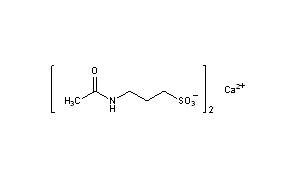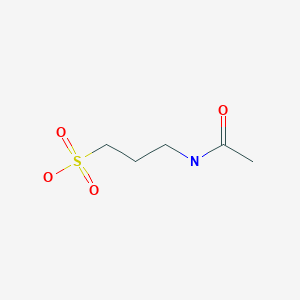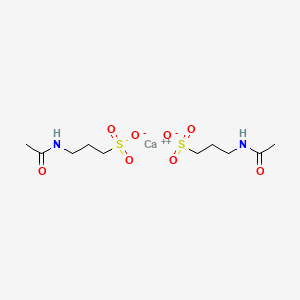Acamprosate calcium
| Molecular Formula: | C10H20CaN2O8S2 |
|---|---|
| Molecular Weight: | 400.474 g/mol |
3-acetamidopropane-1-sulfonic acid
| INGREDIENT | UNII | CAS | fre form
Cas 77337-76-9 181.21 C5H11NO4S |
|---|---|---|---|
| Acamprosate Calcium | 59375N1D0U | 77337-73-6 |
Acamprosate, sold under the brand name Campral, is a medication used along with counselling to treat alcohol dependence.[1][2]
Acamprosate, also known by the brand name Campral™, is a drug used for treating alcohol dependence. Acamprosate is thought to stabilize the chemical balance in the brain that would otherwise be disrupted by alcoholism, possibly by blocking glutaminergic N-methyl-D-aspartate receptors, while gamma-aminobutyric acid type A receptors are activated. Reports indicate that acamprosate only works with a combination of attending support groups and abstinence from alcohol. Certain serious side effects include allergic reactions, irregular heartbeats, and low or high blood pressure, while less serious side effects include headaches, insomnia, and impotence. Acamprosate should not be taken by people with kidney problems or allergies to the drug.
Acamprosate is thought to stabilize chemical signaling in the brain that would otherwise be disrupted by alcohol withdrawal.[3] When used alone, acamprosate is not an effective therapy for alcoholism in most individuals;[4] however, studies have found that acamprosate works best when used in combination with psychosocial support since it facilitates a reduction in alcohol consumption as well as full abstinence.[2][5][6]
Serious side effects include allergic reactions, abnormal heart rhythms, and low or high blood pressure, while less serious side effects include headaches, insomnia, and impotence.[7] Diarrhea is the most common side-effect.[8] Acamprosate should not be taken by people with kidney problems or allergies to the drug.[9]
Until it became a generic in the United States, Campral was manufactured and marketed in the United States by Forest Laboratories, while Merck KGaA markets it outside the US.
Medical uses
Acamprosate is useful when used along with counselling in the treatment of alcohol dependence.[2] Over three to twelve months it increases the number of people who do not drink at all and the number of days without alcohol.[2] It appears to work as well as naltrexone.[2]
Contraindications
Acamprosate is primarily removed by the kidneys and should not be given to people with severely impaired kidneys (creatinine clearance less than 30 mL/min). A dose reduction is suggested in those with moderately impaired kidneys (creatinine clearancebetween 30 mL/min and 50 mL/min).[1][10] It is also contraindicated in those who have a strong allergic reaction to acamprosate calcium or any of its components.[10]
Adverse effects
The US label carries warnings about increased of suicidal behavior, major depressive disorder, and kidney failure.[1]
Adverse effects that caused people to stop taking the drug in clinical trials included diarrhea, nausea, depression, and anxiety.[1]
Other frequent adverse effects include headache, stomach pain, back pain, muscle pain, joint pain, chest pain, infections, flu-like symptoms, chills, heart palpitations, high blood pressure, fainting, vomiting, upset stomach, constipation, increased appetite, weight gain, edema, sleepiness, decreased sex drive, impotence, forgetfulness, abnormal thinking, abnormal vision, distorted sense of taste, tremors, runny nose, coughing, difficulty breathing, sore throat, bronchitis, and rashes.[1]
Pharmacology
Pharmacodynamics
The pharmacodynamics of acamprosate is complex and not fully understood;[11][12][13] however, it is believed to act as an NMDA receptor antagonist and positive allosteric modulator of GABAA receptors.[12][13]
Ethanol and benzodiazepines act on the central nervous system by binding to the GABAA receptor, increasing the effects of the inhibitory neurotransmitter GABA (i.e., they act as positive allosteric modulators at these receptors).[12][4] In chronic alcohol abuse, one of the main mechanisms of tolerance is attributed to GABAA receptors becoming downregulated (i.e. these receptors become less sensitive to GABA).[4] When alcohol is no longer consumed, these down-regulated GABAA receptor complexes are so insensitive to GABA that the typical amount of GABA produced has little effect, leading to physical withdrawal symptoms;[4] since GABA normally inhibits neural firing, GABAA receptor desensitization results in unopposed excitatory neurotransmission (i.e., fewer inhibitory postsynaptic potentialsoccur through GABAA receptors), leading to neuronal over-excitation (i.e., more action potentials in the postsynaptic neuron). One of acamprosate’s mechanisms of action is the enhancement of GABA signaling at GABAA receptors via positive allosteric receptor modulation.[12][13] It has been purported to open the chloride ion channel in a novel way as it does not require GABA as a cofactor, making it less liable for dependence than benzodiazepines. Acamprosate has been successfully used to control tinnitus, hyperacusis, ear pain and inner ear pressure during alcohol use due to spasms of the tensor tympani muscle.[medical citation needed]
In addition, alcohol also inhibits the activity of N-methyl-D-aspartate receptors (NMDARs).[14][15] Chronic alcohol consumption leads to the overproduction (upregulation) of these receptors. Thereafter, sudden alcohol abstinence causes the excessive numbers of NMDARs to be more active than normal and to contribute to the symptoms of delirium tremensand excitotoxic neuronal death.[16] Withdrawal from alcohol induces a surge in release of excitatory neurotransmitters like glutamate, which activates NMDARs.[17] Acamprosate reduces this glutamate surge.[18] The drug also protects cultured cells from excitotoxicity induced by ethanol withdrawal[19] and from glutamate exposure combined with ethanol withdrawal.[20]
Pharmacokinetics
Acamprosate is not metabolized by the human body.[13] Acamprosate’s absolute bioavailability from oral administration is approximately 11%.[13] Following administration and absorption of acamprosate, it is excreted unchanged (i.e., as acamprosate) via the kidneys.[13]
History
Acamprosate was developed by Lipha, a subsidiary of Merck KGaA.[21] and was approved for marketing in Europe in 1989.[citation needed]
In October 2001 Forest Laboratories acquired the rights to market the drug in the US.[21][22]
It was approved by the FDA in July 2004.[23]
The first generic versions of acamprosate were launched in the US in 2013.[24]
As of 2015 acamprosate was in development by Confluence Pharmaceuticals as a potential treatment for fragile X syndrome. The drug was granted orphan status for this use by the FDA in 2013 and by the EMA in 2014.[25]
Society and culture
“Acamprosate” is the INN and BAN for this substance. “Acamprosate calcium” is the USAN and JAN. It is also technically known as N-acetylhomotaurine or as calcium acetylhomotaurinate.
It is sold under the brand name Campral.[1]
Research
In addition to its apparent ability to help patients refrain from drinking, some evidence suggests that acamprosate is neuroprotective (that is, it protects neurons from damage and death caused by the effects of alcohol withdrawal, and possibly other causes of neurotoxicity).[18][26]
References
- ^ Jump up to:a b c d e f g h i j k l m “Campral label” (PDF). FDA. January 2012. Retrieved 27 November2017. For label updates see FDA index page for NDA 021431
- ^ Jump up to:a b c d e Plosker, GL (July 2015). “Acamprosate: A Review of Its Use in Alcohol Dependence”. Drugs. 75 (11): 1255–68. doi:10.1007/s40265-015-0423-9. PMID 26084940.
- Jump up^ Williams, SH. (2005). “Medications for treating alcohol dependence”. American Family Physician. 72 (9): 1775–1780. PMID 16300039.
- ^ Jump up to:a b c d Malenka RC, Nestler EJ, Hyman SE, Holtzman DM (2015). “Chapter 16: Reinforcement and Addictive Disorders”. Molecular Neuropharmacology: A Foundation for Clinical Neuroscience (3rd ed.). New York: McGraw-Hill Medical. ISBN 9780071827706.
It has been hypothesized that long-term ethanol exposure alters the expression or activity of specific GABAA receptor subunits in discrete brain regions. Regardless of the underlying mechanism, ethanol-induced decreases in GABAA receptor sensitivity are believed to contribute to ethanol tolerance, and also may mediate some aspects of physical dependence on ethanol. … Detoxification from ethanol typically involves the administration of benzodiazepines such as chlordiazepoxide, which exhibit cross-dependence with ethanol at GABAA receptors (Chapters 5 and 15). A dose that will prevent the physical symptoms associated with withdrawal from ethanol, including tachycardia, hypertension, tremor, agitation, and seizures, is given and is slowly tapered. Benzodiazepines are used because they are less reinforcing than ethanol among alcoholics. Moreover, the tapered use of a benzodiazepine with a long half-life makes the emergence of withdrawal symptoms less likely than direct withdrawal from ethanol. … Unfortunately, acamprosate is not adequately effective for most alcoholics.
- Jump up^ Mason, BJ (2001). “Treatment of alcohol-dependent outpatients with acamprosate: a clinical review”. The Journal of Clinical Psychiatry. 62 Suppl 20: 42–8. PMID 11584875.
- Jump up^ Nutt, DJ (2014). “Doing it by numbers: A simple approach to reducing the harms of alcohol”. JOURNAL OF PSYCHOPHARMACOLOGY. 28: 3–7. doi:10.1177/0269881113512038. PMID 24399337.
- Jump up^ “Acamprosate”. drugs.com. 2005-03-25. Archived from the original on 22 December 2006. Retrieved 2007-01-08.
- Jump up^ Wilde, MI; Wagstaff, AJ (June 1997). “Acamprosate. A review of its pharmacology and clinical potential in the management of alcohol dependence after detoxification”. Drugs. 53(6): 1038–53. doi:10.2165/00003495-199753060-00008. PMID 9179530.
- Jump up^ “Acamprosate Oral – Who should not take this medication?”. WebMD.com. Retrieved 2007-01-08.
- ^ Jump up to:a b Saivin, S; Hulot, T; Chabac, S; Potgieter, A; Durbin, P; Houin, G (Nov 1998). “Clinical Pharmacokinetics of Acamprosate”. Clinical Pharmacokinetics. 35 (5): 331–345. doi:10.2165/00003088-199835050-00001. PMID 9839087.
- Jump up^ “Acamprosate: Biological activity”. IUPHAR/BPS Guide to Pharmacology. International Union of Basic and Clinical Pharmacology. Retrieved 26 November 2017.
Due to the complex nature of this drug’s MMOA, and a paucity of well defined target affinity data, we do not map to a primary drug target in this instance.
- ^ Jump up to:a b c d “Acamprosate: Summary”. IUPHAR/BPS Guide to Pharmacology. International Union of Basic and Clinical Pharmacology. Retrieved 26 November 2017.
Acamprosate is a NMDA glutamate receptor antagonist and a positive allosteric modulator of GABAA receptors.
Marketed formulations contain acamprosate calcium - ^ Jump up to:a b c d e f “Acamprosate”. DrugBank. University of Alberta. 19 November 2017. Retrieved 26 November 2017.
Acamprosate is thought to stabilize the chemical balance in the brain that would otherwise be disrupted by alcoholism, possibly by blocking glutaminergic N-methyl-D-aspartate receptors, while gamma-aminobutyric acid type A receptors are activated. … The mechanism of action of acamprosate in maintenance of alcohol abstinence is not completely understood. Chronic alcohol exposure is hypothesized to alter the normal balance between neuronal excitation and inhibition. in vitro and in vivostudies in animals have provided evidence to suggest acamprosate may interact with glutamate and GABA neurotransmitter systems centrally, and has led to the hypothesis that acamprosate restores this balance. It seems to inhibit NMDA receptors while activating GABA receptors.
- Jump up^ Malenka RC, Nestler EJ, Hyman SE (2009). “Chapter 15: Reinforcement and Addictive Disorders”. In Sydor A, Brown RY. Molecular Neuropharmacology: A Foundation for Clinical Neuroscience (2nd ed.). New York: McGraw-Hill Medical. p. 372. ISBN 9780071481274.
- Jump up^ Möykkynen T, Korpi ER (July 2012). “Acute effects of ethanol on glutamate receptors”. Basic & Clinical Pharmacology & Toxicology. 111 (1): 4–13. doi:10.1111/j.1742-7843.2012.00879.x. PMID 22429661.
- Jump up^ Tsai, G; Coyle, JT (1998). “The role of glutamatergic neurotransmission in the pathophysiology of alcoholism”. Annual Review of Medicine. 49: 173–84. doi:10.1146/annurev.med.49.1.173. PMID 9509257.
- Jump up^ Tsai, GE; Ragan, P; Chang, R; Chen, S; Linnoila, VM; Coyle, JT (1998). “Increased glutamatergic neurotransmission and oxidative stress after alcohol withdrawal”. The American Journal of Psychiatry. 155 (6): 726–32. doi:10.1176/ajp.155.6.726. PMID 9619143.
- ^ Jump up to:a b De Witte, P; Littleton, J; Parot, P; Koob, G (2005). “Neuroprotective and abstinence-promoting effects of acamprosate: elucidating the mechanism of action”. CNS Drugs. 19 (6): 517–37. doi:10.2165/00023210-200519060-00004. PMID 15963001.
- Jump up^ Mayer, S; Harris, BR; Gibson, DA; Blanchard, JA; Prendergast, MA; Holley, RC; Littleton, J (2002). “Acamprosate, MK-801, and ifenprodil inhibit neurotoxicity and calcium entry induced by ethanol withdrawal in organotypic slice cultures from neonatal rat hippocampus”. Alcoholism: Clinical and Experimental Research. 26 (10): 1468–78. doi:10.1097/00000374-200210000-00003. PMID 12394279.
- Jump up^ Al Qatari, M; Khan, S; Harris, B; Littleton, J (2001). “Acamprosate is neuroprotective against glutamate-induced excitotoxicity when enhanced by ethanol withdrawal in neocortical cultures of fetal rat brain”. Alcoholism: Clinical and Experimental Research. 25(9): 1276–83. doi:10.1111/j.1530-0277.2001.tb02348.x. PMID 11584146.
- ^ Jump up to:a b Berfield, Susan (27 May 2002). “A CEO and His Son”. Bloomberg Businessweek.
- Jump up^ “Press release: Forest Laboratories Announces Agreement For Alcohol Addiction Treatment”. Forest Labs via Evaluate Group. October 23, 2001.
- Jump up^ “FDA Approves New Drug for Treatment of Alcoholism”. FDA Talk Paper. Food and Drug Administration. 2004-07-29. Archived from the original on 2008-01-17. Retrieved 2009-08-15.
- Jump up^ “Acamprosate generics”. DrugPatentWatch. Retrieved 27 November 2017.
- Jump up^ “Acamprosate – Confluence Pharmaceuticals – AdisInsight”. AdisInsight. Retrieved 27 November 2017.
- Jump up^ Mann K, Kiefer F, Spanagel R, Littleton J (July 2008). “Acamprosate: recent findings and future research directions”. Alcohol. Clin. Exp. Res. 32 (7): 1105–10. doi:10.1111/j.1530-0277.2008.00690.x. PMID 18540918.
Acamprosate calcium
- ATC:N07BB03
- MW:400.49 g/mol
- CAS-RN:77337-73-6
- EINECS:278-665-3
- LD50:>10 g/kg (M, p.o.)
Derivatives
free acid
- Formula:C5H11NO4S
- MW:181.21 g/mol
- CAS-RN:77337-76-9
- EINECS:278-667-4
Substance Classes
Synthesis Path
Substances Referenced in Synthesis Path
| CAS-RN | Formula | Chemical Name | CAS Index Name |
|---|---|---|---|
| 3687-18-1 | C3H9NO3S | 3-aminopropane-1-sulfonic acid | 1-Propanesulfonic acid, 3-amino- |
| 156-87-6 | C3H9NO | 3-amino-1-propanol | 1-Propanol, 3-amino- |
Trade Names
| Country | Trade Name | Vendor | Annotation |
|---|---|---|---|
| D | Campral | Merck | |
| F | Aotal | Merck Lipha | |
| GB | Campral EC | Merck Serono | |
| USA | Campral | Forest |
Formulations
- tabl. 50 mg, 100 mg, 333 mg
References
-
- DE 3 019 350 (Lab. Meram; appl. 21.5.1980; F-prior. 23.5.1979).
- US 4 355 043 (Lab. Meram; 19.10.1982; F-prior. 23.5.1979).
-
synthesis of 3-aminopropane-1-sulfonic acid:
- Fujii, A. et al.: J. Med. Chem. (JMCMAR) 18, 502 (1975).
- JP 46 002 012 (Kowa; appl. 19.1.1971).
- WO 8 400 958 (Mitsui; appl. 15.3.1984; J-prior. 7.9.1982, 19.7.1983, 8.9.1982).
 |
|
 |
|
| Clinical data | |
|---|---|
| Trade names | Campral EC |
| Synonyms | N-Acetyl homotaurine, Acamprosate calcium (JAN JP), Acamprosate calcium (USANUS) |
| Pregnancy category |
|
| Routes of administration |
Oral [1] |
| ATC code | |
| Legal status | |
| Legal status | |
| Pharmacokinetic data | |
| Bioavailability | 11%[1] |
| Protein binding | Negligible[1] |
| Metabolism | Nil[1] |
| Elimination half-life | 20 h to 33 h[1] |
| Excretion | Renal[1] |
| Identifiers | |
| CAS Number | |
| PubChem CID | |
| IUPHAR/BPS | |
| DrugBank | |
| ChemSpider | |
| UNII | |
| KEGG | |
| ChEBI | |
| ChEMBL | |
| ECHA InfoCard | 100.071.495 |
| Chemical and physical data | |
| Formula | C5H11NO4S |
| Molar mass | 181.211 g/mol |
| 3D model (JSmol) | |
| |
|
////////////////Acamprosate calcium, アカンプロセート
CC(=O)NCCCS(O)(=O)=O
CC(=O)NCCCS(=O)(=O)[O-].CC(=O)NCCCS(=O)(=O)[O-].[Ca+2]


















